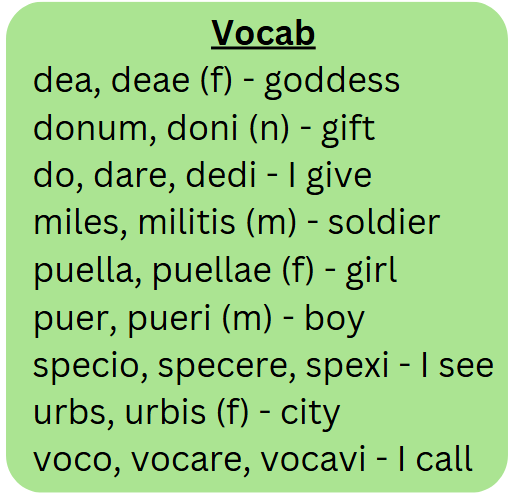Picking up the Perfect
Back to regularly scheduled posts!
How does the Perfect Tense work in Latin?
The Perfect is one of Latin's past tenses, and today we're going to have a look at how to recognise and translate the perfect tense.
Need help with verbs?
If you're struggling with any of your Latin tenses, download my free Latin Verbs Booklet here. It's a complete reference guide to all verb endings. You might not need all of it, you might only need the first page, but go and download it. It's absolutely free, and it's really helpful for learning those endings.
What’s the difference between Present and Perfect?
Look at these two sentences:
I greet the girl
I greeted the girl
They're very similar but there is a key difference. The first one is present tense and the second one is perfect tense. In English, we often express this by adding -ed on the end of the verb. Now look at them in Latin:
puellam saluto
puellam salutavi
In the first one, the present verb ends with an -o. The second one ends with -i. This is really key. First person singular verbs end with -i in the perfect.
Here is the second person singular:
in foro ambulas: “you walk in the forum”
in foro ambulavisti: “you walked in the forum”
Again, the difference is in the verb. The first is present tense, ambulas, and the second is perfect, ambulavisti. This is a very big difference in endings. We have -s in the present, but -isti in the perfect tense.
The third person singular is very similar in present and perfect.
regem laudat: “he praises the king”
regem laudavit: “he praised the king”
The present ends with -t (lauda- is the present stem) and the perfect ends with -it.
Something has changed
There is a big change in each of these between present and perfect. Of course the endings have changed, -i, -isti, -it are the singular perfect endings, rather than the -o, -s, -t of the present. But another key part of the perfect is not just the endings, but how the stem itself changes.
The Perfect Stem
You'll notice that the three perfect verbs we have seen so far seem to have a -V- added to the present stem before the perfect endings. In fact, this is a completely different part of the verb.
So it's not saluti, it's salutavi. Instead of ambulisti, it's ambulavisti, and laudit becomes laudavit.
This is because the perfect tense is formed using the perfect stem and the perfect person endings.
Let's have a look at saluto. In your dictionary, you'll see it like this:
saluto, salutare, salutavi
You might also have a fourth, which is salutatus but we’ll ignore that for now. salutavi is the Perfect stem. It's what's called the third principle part, and it's really essential for when you are learning your perfect verbs. This is because it shows you immediately how the verb is going to change in the perfect tense and in other tenses that use the perfect to form the verb.
For salutavi, the perfect stem is salutav-, and the -i at the end is the person ending.
ambulo is the same: ambulo, ambulare, ambulavi. ambulav- is the perfect stem, and the perfect ending is -i. This person ending just changes based on who is doing the verb. The perfect stem does not change.
laudo, laudare, laudavi. Again, laudav- is the perfect stem, and the -i at the end shows who is doing the verb, in this case the first person singular.
Plural Perfect Endings
So far we just looked at the singular person endings. But what if I want to say “we did something” or “they did something”. I need plural endings.
Let's take ambulo as an example.
ambulavi: I walked
ambulavisti: you (s) walked
ambulavit: he/she walked
ambulavimus: we walked
ambulavistis: you (plr) walked
ambulaverunt: they walked
Each time, the perfect stem stays the same (ambulav-) and all we do is change the ending. -i, -isti, -it, -imus, -istis, -erunt. Get used to saying that because they're really, really important.
“I don’t need to learn the principle parts”
You might be thinking this. You will see the perfect ending looks similar to the present ending, and you might be wondering why this is so important to learn.
However, so far we have only looked at extremely regular verbs in the first conjugation. -are verbs (like saluto, ambulo and laudo) follow the present stem closely.
But Latin is just like English: sometimes (lots of times actually) the nice, neat rules don’t apply. Keep reading and we will look at some more tricky ones.
Changeable verbs
We looked at regular verbs. Now we're going to have a look at some changeable verbs. They are still formed with the perfect stem and the perfect endings. However, their perfect stem might look a little bit different.
video, videre, vidi
“I see”, “to see”, “I saw”
In this case, the perfect stem is not simply the present stem with a -v- added. The whole stem itself is slightly different. This actually is similar to English. We don’t use “seed” as the past tense, the stem changes to “saw”.
conspicio, conspicere, conspexi
“I catch sight of”, “to catch sight of”, “I caught sight of”
The stem here has changed from conspici- in the present to conspex- in the perfect.
do, dare, dedi
“I give”, “to give”, “I gave”
This one is very different, but you can see that it still has the perfect endings. dedi, dedisti, dedit, dedimus, dedistis, dederunt. The endings are just added to that perfect stem.
NB: It doesn’t completely track that changeable stems in Latin correspond to the changeable verbs in English when translated. dormio, dormire, dormivi is regular in Latin, but “sleep” goes to “slept” in English. However, the examples are helpful to bear in mind!
in via sedemus: “we sit in the street”
in via sedimus: “we sat in the street”
I have two different tenses of this sentence. It's a very slight difference. The first one has sedemus is with the present stem sede-. However, the second one sedimus is with the perfect stem sed-, with the perfect first person plural ending -imus. The difference can be very, very slight sometimes, and you have to be careful.
The super important thing, therefore, when learning perfect verbs is the third principle part of your verbs. If you look in your dictionary, it will tell you how that verb changes in the perfect tense. Get used to looking at those third principle parts. They're really important when learning vocabulary.
Perfect Tense Sentences
Let's have a look at these examples. If you want to have a go at them on your own, use the vocab list below to help, and then keep reading to get the answers and walkthrough.
pueri puellam vocaverunt
mercatores vidimus
miles urbem spexit
donum deae dedistis
Walkthrough and translation
Answers here, only keep reading when ready!
pueri puellam vocaverunt.
I'm going to look at the verb first because it tells me the most about the sentence, so at the end of my sentence, vocaverunt is my verb. It comes from voco, which is at the bottom of my list, voco vocare vocavi. If I take vocav-, that's my perfect stem, and -erunt is the “they” form of the verb. So I know this means “they called” in the perfect tense.
Because my verb is third plural, I now look to see if there is a plural nominative. pueri fits, “the boys called”.
puellam, “the girl” is accusative, so she is the one receiving the action
“The boys called the girl”
mercatores vidimus.
mercatores could be nominative or accusative plural, so I'm going to ignore it for now and have a look at the verb.
vidimus is my verb, and it comes from video, which I haven't written on my vocab list because we had it just above. video is “I see”, but vidimus is formed using the perfect stem vidi. That tells me it's “we saw” in the perfect tense.
Now back to mercatores. It is a plural noun, and it could be nominative: “we merchants saw”, but I'm not being told what we saw. So instead, I am going to use logic, and I'm going to assume it is accusative, as this makes more sense in English.
“We saw the merchants”
miles urbem spexit.
spexit is the verb. It comes from specio which is in my vocablist: specio, specere, spexi. So I know this is a perfect verb because it's got the -X- in it, spexit. I also know that it is the “he/she/it” ending. So “he or she, or it saw”
miles is a nominative singular and it means “the soldier”. So that fits with spexit as a singular nominative. So the soldier saw the urbem, the city, an accusative noun.
“The soldier saw the city”
donum deae dedistis.
This one's a little bit trickier, so let's look at the verb first. dedistis comes from do dare dedi, which is the third word on my vocab list. do means “I give”. dedi is the perfect stem, so dedistis means “you plural gave”.
Now deae I could be nominative plural, which would mean “you goddesses gave”. Let's see if that makes sense. You goddesses gave what? donum, “the gift”.
Now that could make sense, however, we're not often going to be speaking to goddesses. So what else could it mean?
It could mean dedistis “you gave” donum “the gift”, and deae could be dative singular. “To the goddess”. That makes much more sense to me. Hopefully it'll be clear from context in the passage you're doing, whether it's you goddesses that we're talking to, or whether it's a dative singular. Because it's following the verb give I'm going to assume it's dative.“You (plr) gave the gift to the goddess”
Picked up the Perfect
And that's all there is to the regular perfect verbs! If you haven’t already, subscribe to get my post about irregular perfect verbs which will be coming in the near future.
Make sure you download my free reference guide to Latin verbs. It's really helpful just to give you the tables of the ending so you can have it to hand while you're having a look at some translations!
I hope this has been useful. Let me know what you think in the comments, and I'll see you next time on bambasbat!



